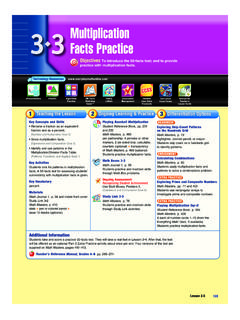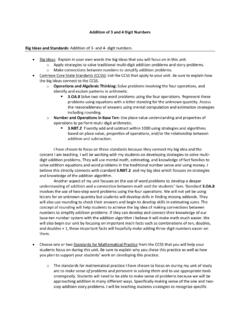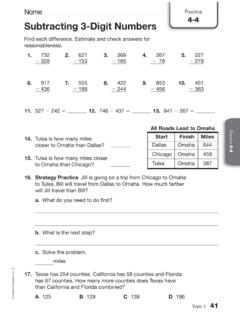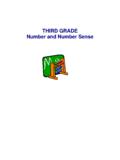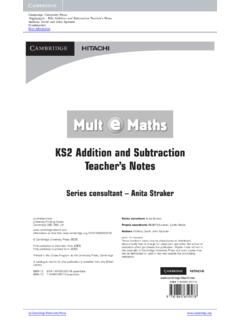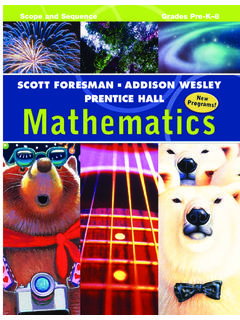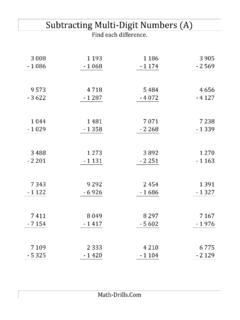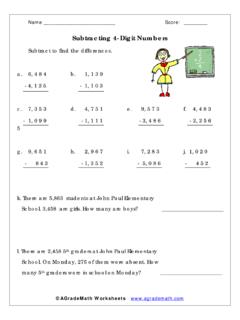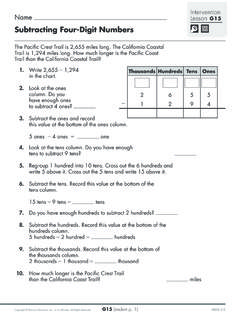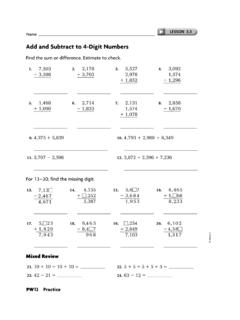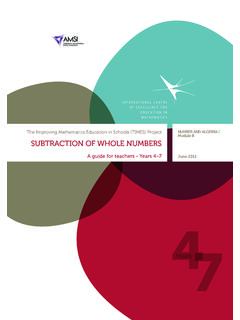Transcription of Adding and Subtracting 2-Digit Numbers - Everyday Math
1 Teacher s Lesson GuideAlgorithms PracticeEM FactsWorkshopGame Family LettersCurriculumFocal PointsAssessmentManagementCommon Core State Standards758 Unit 9 Place Value and FractionsAdvance PreparationYou may want to make a transparency of Home Link 9 3 to use when you go over the answers. Teacher s Reference Manual, Grades 1 3 p. 161 Key Concepts and Skills Explain strategies used to solve problems involving the addition and subtraction of 2-Digit by 2-Digit Numbers . [Operations and Computation Goal 2] Add and subtract 2-Digit Numbers using strategies based on place value and the relationship between addition and subtraction.
2 [Operations and Computation Goal 2] Tell, write, and solve number stories. [Operations and Computation Goal 4] Write addition and subtraction number sentences using +, -, and =. [Patterns, Functions, and Algebra Goal 2] Use the properties of operations to add and subtract 2-Digit Numbers . [Patterns, Functions, and Algebra Goal 3]Key ActivitiesChildren use the data on their animal cards to make up and solve addition and subtraction number Assessment: Informing Instruction See page Journal 2, p. 182 Home Link 9 3slate animal cards from Unit 5 number -Grid Poster base-10 blocks (optional)Practicing with Name-Collection BoxesMath Masters, p.
3 262 Children use name-collection boxes to find equivalent names for Boxes 9 4 Math Journal 2, p. 183 Children practice and maintain skills through Math Box Assessment: Recognizing Student Achievement Use Math Boxes, Problem 3. [ number and Numeration Goal 4]Home Link 9 4 Math Masters, p. 263 Children practice and maintain skills through Home Link 2-Digit Addition and Subtractionper partnership: 2 each of number cards 0 9 (from the Everything Math Deck, if available),base-10 blocks (longs and cubes), 1 penny, slate (optional)Children use base-10 blocks to review Adding and Subtracting 2-Digit the Sums of 2-Digit by 2-Digit Addition Problemsanimal cards from Unit 5 Children solve two- digit addition problems and compare the SUPPORT Comparing the Weights of Objectsper group.
4 Bath scale, objects to weighChildren weigh objects and order and compare the Les sonOngoing Learning & PracticeDifferentiation OptionsAdding and Subtracting 2-Digit NumbersObjective To provide practice Adding and Subtracting 2-Digit 7583/17/11 12:39 PM3/17/11 12:39 PM1 Teaching the Lesson Math Message Follow-Up WHOLE-CLASS ACTIVITYB riefly go over the answers. The rabbit is the shortest animal on the cards; the porpoise is the longest. Discuss the meaning of the words length and height. Make sure children understand that height is used to refer to how tall someone or something is. Length is the size of something from one end to the other.
5 Creating and Solving WHOLE-CLASS ACTIVITYS illy Animal Stories(Math Journal 2, p. 182)Ask children to find the animal-card pictures of the rabbit and the raccoon. Then pose the following number story: Suppose the rabbit and the raccoon lie nose to nose. What will be their total length?Have children share solution strategies. Some children may have added mentally and reasoned as follows: Eleven is 1 more than 10. So I added 10 to 23; that s 33. Then I added 1 more; that s 34. Demonstrate this strategy on the number -Grid Poster: Start at 23, add 10 by moving down one row to 33, then add 1 by moving one space to the number story by drawing a parts-and-total diagram and writing a number children to make up number stories about comparing or finding total lengths or weights of two animals on their cards.
6 Suggest that they imagine two animals on the same weighing scale or one animal sitting on top of another. To support English language learners, discuss the meanings of the words weight and Journal 2, p. 182 Student PageLesson 9 4759 Getting StartedMath MessageTake out your animal cards. Look at the side that shows the animal s length in inches. Which animal is the shortest? Which is the longest?Home Link 9 3 Follow-Up Briefly go over the answers. Ask children to describe how they used number -grid patterns to help them complete the Math and ReflexesHave children answer the following rounding questions on their slates:Is 17 closer to 10 or 20?
7 20 Is 24 closer to 20 or 30? 20 What multiple of 10 is closest to 33? 30 To 68? 70 To 86? 90Is 120 closer to 100 or 200? 100 Is 175 closer to 100 or 200? 7592/1/11 3:41 PM2/1/11 3:41 PM10 + 10 + 550 - 203 dimesSample answers: 33 - 3 LESSON9 4 Name DateName-Collection Boxes1. Add 5 names. 2. Fill in the label. Add 5 Cross out names that do 4. Cross out names that do not not belong. belong. Add 2 names. Answers + 15 Answers + 3 + 3 + 3 60 - 1010 + 10 + 10 + 10 + 10////\ ////\ ////\ ////\ ////\25 + 2622/8/11 4:09 PMMath Masters, p.
8 262 Teaching Master760 Unit 9 Place Value and FractionsAdjusting the ActivitySuggested number stories: If the koala stood on top of the penguin s head, how tall would they be together? 60 in. If the fox sat on top of the beaver, how much would they weigh together? 70 lb How much taller is the boy than the girl? 7 in. How much more does the cheetah weigh than the boy? 70 lbTell children to solve the number stories any way they can. Encourage children to use concrete models, such as base-10 blocks, and drawings to solve the problems. Have children share their solution strategies, and encourage them to try new strategies on subsequent number stories.
9 For instance, you may wish to have children practice some common addition and subtraction strategies with the following number stories: Counting on from the larger addend: How much do the 15 lb eagle and the 7 lb cat weigh together? Start with the larger weight, 15 lb, and count up 7 lb to get 22 lb total. Making ten: If the 48 in. cheetah and the 23 in. raccoon sleep head-to-toe in a line, how long would they be together? Use base-10 blocks to represent the cheetah s length (4 longs, 8 cubes) and the raccoon s length (2 longs, 3 cubes). Add tens to tens and ones to ones to get 6 longs, 11 cubes. Trade 10 cubes for one long, composing a new ten and leaving 1 cube left over.
10 The length is 7 tens, 1 one, or 71 inches total. Counting up to subtract: How much more does the 50 lb boy weigh than the 41 lb girl? Count up from 41 lb to 50 lb, a 9 lb discussing solutions, display the appropriate unit box on the board. Ask children to suggest a number model for the problem. Keep in mind that more than one model may be appropriate. For example, when comparing the heights of the boy and the girl, the counting-up strategy can be represented by the addition number model 43 + 7 = 50 or the subtraction number model 50 43 = 7. Summarize with an appropriate situation children model the number stories with base-10 blocks as they did in Lesson 5-5 with animal weight number KINESTHETIC TACTILE VISUALO ngoing Assessment: Informing InstructionWatch for children who have trouble deciding whether to add or subtract when solving a number story.
